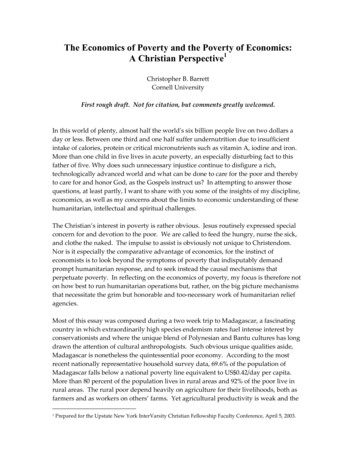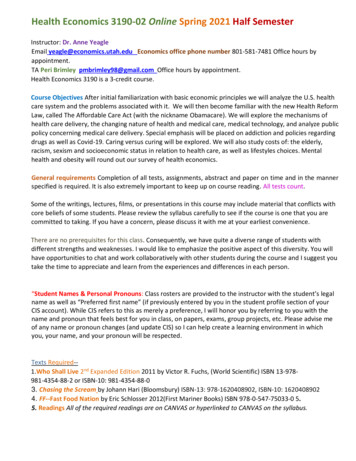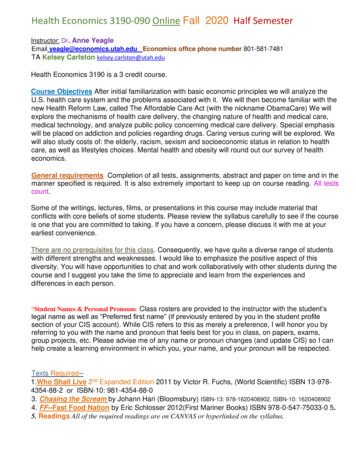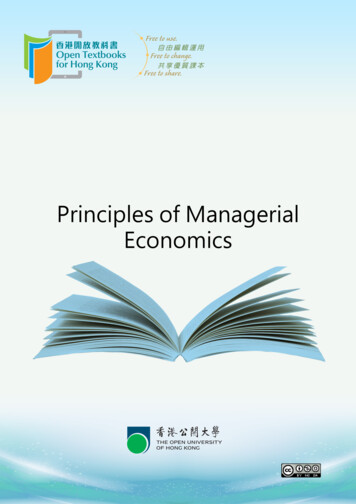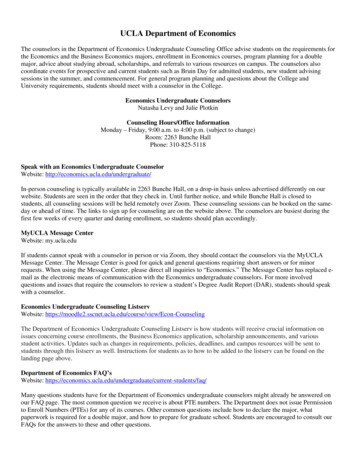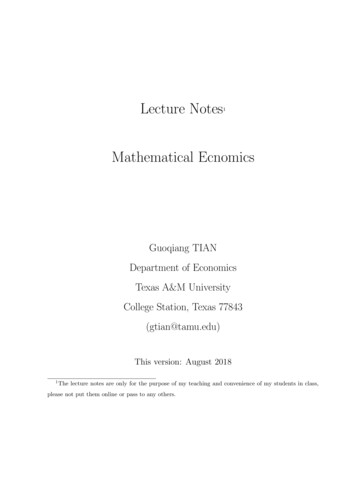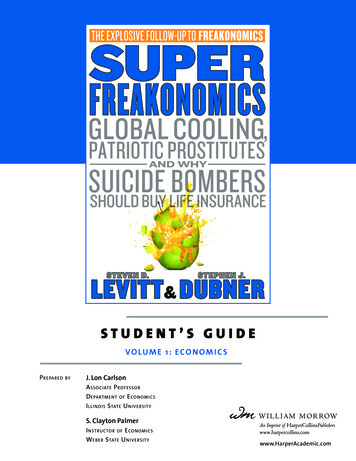
Transcription
Student’s GuideVo l u m e 1 : E co n o m i c sP reparedbyJ. Lon CarlsonA ssociate P rofessorD epartment of E conomicsI lli nois S tate U n iversityS. Clayton PalmerI nstructor of E conomicsW eber S tate U n iversitywww.HarperAcademic.com
P r e fa c eIntroductionWelcome to the Student’s Guide to SuperFreakonomics! The purpose of this guide is to help youbetter understand the analyses presented in SuperFreakonomics by providing a sort of “bridge”between the material covered in a traditional course in Economic principles and topics addressedin what we consider to be one of the most fascinating books we’ve encountered in the economicsliterature.Many students view economics as a very difficult, if not impossible, course to master. This perception is, however, most likely based on the whining of fellow students who did not apply the properapproach to learning economics. In many courses, simple memorization is enough. In economics,this is not the case. While you need to understand the meaning of basic terms and concepts, youalso need to be able to apply economic concepts in specific situations. In other words, you need todevelop the ability to think like an economist. The authors of SuperFreakonomics certainly show youhow to do just that. The material presented here is intended to make your job easier still.Organization of the Student’s GuideWe organized the material in this guide to help you identify the key points in each chapter and toensure that you have a firm grasp of the key concepts presented in the book. The first section ofeach chapter in this guide consists of an overview that highlights the major topics and points presented in the book. The overview is designed to alert you to the major topics and is not intended toserve, in any way, as a substitute for the material in the text.The second section of each chapter highlights key economic concepts that are addressed in the corresponding book chapter. In addition, we provide graphical illustrations at various points along theway to help you better understand how to use basic economic models to illustrate relationships discussed in the book. The purpose of this discussion is to alert you to the major factors that affect therelationship being illustrated. In order to be able to use graphs to analyze the effects of changes inkey economic variables, you must have a clear understanding of how the determinants of the relationship being illustrated in a graph are related.The third section of each chapter consists of a list of what we have termed “core competencies.”How well you are able to respond to each of the questions listed in this section will be a strong indicator of the extent to which you understand the material presented in the book.Using the Student GuideWhen using the student guide, remember that the overview and discussions of key graphs andterms are not substitutes for reading SuperFreakonomics. Instead they are designed to “flag” key2
topics and alert you to specific items you may have missed. When completing the “core competency” questions, we strongly recommend that you avoid using your book or notes to answer thequestions on your initial run through. Instead, use the questions as a way to flag topics you havenot yet mastered. When you cannot answer a specific question, or you answer it incorrectly, youshould take that as a signal to go back and devote more study to the topic in question.Another Useful SuggestionThis guide is one of two prepared for the student. The other guide is directed at students taking aclass in statistics or quantitative analysis. You may also find this useful.Chapter 1How Is a Street Prostitute Like a Department-Store Santa?SummaryLevitt and Dubner begin Chapter 1 by describing some of the ways women have been abused anddiscriminated against over time. Then, they point out that although conditions in certain countrieshave improved dramatically over the last few decades, women still suffer the effects of discrimination. This is especially true in the labor market, where a significant wage differential between menand women continues to persist despite increased educational opportunities and legislative initiatives such as Title IX. This leads to consideration of the labor market in which women clearly dominate the supply side—the market for prostitution.There is no doubt but that this topic may prove particularly uncomfortable for many of you. Thediscomfort factor notwithstanding, however, this topic also demonstrates how economic analysiscan provide an objective assessment of at least some of the benefits and costs of a profession thatprovokes a vast range of responses from outside observers. Focus on the data.The authors begin their analysis of the market for prostitution by describing what the market waslike at the turn of the century in Chicago, and how the subsequent criminalization of this activityaffected wages and working conditions over time. Information on relative wages in absolute andcurrent dollars suggests why so many women would consider working as a prostitute. Focusingon the upscale Everleigh Club, the authors also show how manipulation of supply and demandthrough product differentiation—supply a service that entails greater marginal costs and targetthat segment of consumers with greater willingness to pay—could result in a price much higherthan the broader market equilibrium. They then provide useful insights regarding how society’sobjectives might be best met when it comes to enforcement of certain laws, i.e., it is more effectiveto focus on demand than supply if certain activities are going to be effectively curtailed.3
The next part of the chapter focuses on information gleaned from data collection efforts by SudhirVenkatesh that shed considerable light on the current conditions in the market for prostitution inChicago, ranging from wages and prices for various services rendered to the effects of relying onmarketers (e.g., pimps) to sell one’s products or services. At this point, the authors also demonstratethat what may be true in one market—pimps tend to improve market outcomes for prostitutes—may not hold elsewhere, e.g., procuring the services of a realtor does not necessarily leave the sellerof a house better off. This portion of the chapter concludes with an examination of the role thepolice play in controlling prostitution and how the solutions they devise can be at odds with theobjectives of policymakers, i.e., the principal-agent problem.Attention then turns to consideration of how the increase in the range of opportunities for educated women to work outside of teaching has simultaneously increased their average pay and disadvantaged school children. The latter is simply a result of a decrease in the average level of abilityof people entering the labor market for teachers. The authors then consider several possible explanations for the wage gap between men and women that continues to exist even after the increasein the availability of higher paying jobs for women. The final section tells the story of a woman whodecided to become a prostitute on her own terms, and how she used sound marketing strategiesand economic principles to achieve a considerable level of financial success.Basic Economic Concepts1. Supply and demand. The model of supply and demand is used to illustrate how the equilibriumprice and quantity of a good (or service) are determined by the interaction of sellers (supply)and buyers (demand) in a market. In addition, the model is used to predict how a change in oneor more of the determinants of demand or supply can be expected to alter the existing marketequilibrium.This chapter clearly demonstrates that the marketPfor labor services, even prostitution, operates likethe market for any other good or service. Changesin supply or demand will induce changes in equilibrium price (the wage) and quantity, and createP1additional incentives for suppliers and consumersto enter or leave the market. Thus for example,criminalizing prostitution and arresting some sup- P2pliers caused the supply of prostitutes to decrease.This is shown in Figure 1.1, which depicts themarket for prostitution, by the shift of the supplycurve from S1 to S2. All else constant, this createda shortage at the original equilibrium price, P1.This in turn caused market price to increase, whichattracted additional workers, whose reservationS2S1D1Q2Q12Figure 1.1Q4
wage was higher, into the market. The end result was a higher equilibrium price, P2, and lower equilibrium quantity, Q2.The discussion of changes in the market for teachers can also be illustrated in the supply-demandframework. As the authors point out, as more employment opportunities developed for women,many highly skilled women who had previously gone into teaching opted for more financially lucrative occupations. As such the average marginal productivity of those individuals entering teachingis presumably lower than it was previously. In this example, marginal product refers to the addition to output, i.e., learning, attributable to each additional teacher who is hired. This caused thedemand curve for teachers to shift left, all else constant. This is because the demand for labor isassumed to depend on the marginal productivity of each worker and the market price of the outputproduced by that worker. Holding market price constant, as the marginal product of each workeddeclines, the total value of output produced by that worker declines as well. The result is a lowermarginal product: students lose.2. Price elasticity of demand. The price elasticity of demand, which is a measure of the sensitivity of quantity demanded to a change in price, is calculated by dividing the percentage changein quantity demanded by the corresponding percentage change in price. The price elasticity ofdemand is useful in a number of different situations. For example, if we know whether demandis elastic (the percentage change in quantity demanded is greater than the corresponding percentage change in price) or in elastic (the percentage change in quantity demanded is less thanthe corresponding percentage change in price) over a specific range of the demand curve, wecan then determine whether a change in price will cause total revenues to increase or decrease.To understand this, begin with the fact that when price changes, quantity demanded changesin the opposite direction. Because total revenue is simply price times quantity, the effect of theprice change on total revenue is unclear. However, knowing the price elasticity of demand tellsus which effect, the change in price or the change in quantity demanded, is stronger and, hence,whether total revenue will increase or decrease.Two examples in this chapter illustrate the effects of the price elasticity of demand on total revenues when price changes. The first is the discussion of how arresting some prostitutes causedprices to increase. The resulting reduction in supply put upward pressure on price, which patronsapparently readily agreed to pay, suggesting demand is relatively price inelastic, i.e., the percentageincrease in price is greater than the percentage decrease in quantity demanded. Assuming this is, infact, the case, the overall effect would be to cause the total revenues of the prostitutes who are stillworking to increase.The second example involves Allie, who decided to explore the demand curve for her servicesby steadily increasing her prices over a relatively short period of time. As the discussion implies,demand for her services was in fact rather inelastic. We can conclude this based on the fact that asprice increased, so did her total revenues.3. Price Discrimination. Price discrimination refers to the act of charging different prices to different groups of customers for the same good or service. For price discrimination to be successful,5
the seller has to be able to effectively prevent resale of the good or service. If she could not, thecustomer charged the lower price could profitably resell the item to the customer who is normally charged the higher price at a price that is lower than the seller would charge the higherprice customer. Another other condition for successful price discrimination is some customersmust clearly possess identifiable traits that place them in the willingness-to-pay-more category.A street prostitute uses her experience to identify and categorize customers. One of the easiestto-observe traits her customer possesses is skin color. Based on the data (and, no doubt, theprostitute’s experience), white customers pay more than black customers.Based on the foregoing observations, the market for prostitution clearly satisfies the conditionsfor successful price discrimination. And the data, combined with information from surveys aboutthe pricing strategies employed by prostitutes, demonstrate how price discrimination can workto the benefit of the supplier. This is because without price discrimination, the same price wouldbe charged to all customers. By price discriminating, however, the seller can increase the revenuesearned from different groups of customers and, in so doing, increase profits.4. Substitutes and market demand. The determinants of the market demand for a good orservice include the item’s price, the numberof consumers, consumers’ incomes, expectations, tastes and preferences, and the pricesof related goods, i.e., substitutes and complements. A change in any of the determinantsof demand other than the price of the good orservice will cause the demand for the good toincrease or decrease. The change in demandcauses the entire demand curve to shift.Understanding this, we can then answer thequestion: Why did the number of prostitutes,measured as a percentage of the population,decline over time? It did so because availablesubstitutes for paid sex—in particular, casualsex—increased. When the supply of casual sexincreased, pushing down its price, the demandfor a substitute, i.e., a prostitute, necessarilydecreased as well.PS1P1P2D1D2Q2Q12Figure 1.2QThis is shown in Figure 1.2, which depicts the market for prostitution, by a leftward shift of thedemand curve from D1 to D2. All else constant, the decrease in demand in the market for prostitutes caused the equilibrium price and quantity to decrease as well, to P2 and Q2.5. Product differentiation. Firms are constantly trying to escape the forces of competition in hopesof increasing their total profits. An effective way of doing this is through product differentiation.To the extent that a firm is able to successfully distinguish its product from those of its6
competitors, the number of available substitutes is effectively decreased. Moreover, as thenumber of substitutes decreases, all else constant, so does the price elasticity of demand for thefirm’s product and, hence, the firm’s ability to increase price and total revenue.The discussion of the Everleigh Club provides an excellent illustration of the benefits a firm canreap from product differentiation. By providing services others did not, as well as a better qualityservice—educated, healthy women who possess an engaging personality—the owners of the cluband their employees were able to earn incomes much greater than the average wage in the marketfor prostitution at that time.In contrast, the data also show that, at the present time, the average price paid for the services of aprostitute at one location doesn’t differ from the average price paid at another location. The explanation for this is that although street prostitutes may attempt to differentiate themselves fromone another, and while one prostitute may be more attractive than another, their male customersview them as perfect substitutes.6. Incentives matter. One of the dominant themes in virtually every economics course is “incentives matter.” A rather basic assumption is that buyers and sellers will act so as to make themselves as well off as possible. Consumers try to maximize total satisfaction, while sellers try tomaximize profits. This brings us to the title of this chapter. Why would someone dress up in aSanta costume? And, more importantly, why would someone who normally works in a legalprofession suddenly engage in prostitution? The answer is simple: When market prices rise andprofits dramatically increase. The incentive created by the relative wages offered by prostitutionas compared to more mundane jobs (e.g., housekeeper, laborer) also helps explain why so manywomen engaged in prostitution at the turn of the century.Core CompetenciesOnce you have read and carefully studied this chapter you should be able to complete the followingtasks. (Note: the economic principles illustrated in SuperFreakonomics don’t necessarily “track” withthe order in which they appear in an economics text book. Therefore, some of the economic concepts described below may be new to you.)1. Describe how men and women have compared over time with respect to such factors as lifeexpectancy, discrimination, and abuse. How has the comparison between the two changed overthe past 100 years?2. Describe how the incomes earned by men and women compare at the present time. Is therea significant difference? Describe the factors that are believed to account for the observedwage gap.3. Describe how women have fared with respect to participation in sports, educational opportunities, and incomes in the time since Title IX became law. In addition, to what extent has this lawbenefitted female coaches of college women’s sports teams?7
4. Compare and contrast the conventional wisdom and reality regarding prostitution in the UnitedStates at the turn of the century. Focus, in particular, on the perception of “white slavery” versusthe results of a study of prostitution in the United States by the Department of Justice.5. Compare the average wages earned by women in legal professions, e.g., seamstress, cleaningwoman, to those earned by prostitutes in Chicago at the turn of the century.6. Describe how the revenues earned by the proprietors and the employees of the Everleigh Clubcompared to the average for prostitutes in Chicago. What factors accounted for this difference?7. Using a simple model of supply and demand, explain how efforts to shut down the marketfor prostitution by curtailing supply compare to the outcome when the focus is on reducingdemand. In particular, how would each policy affect the equilibrium price and quantity in themarket for prostitution?8. Explain why the method Sudhir Venkatesh used to collect data on prostitution in Chicago issuperior to more traditional survey methods, particularly with respect to the reliability of theresulting data.9. Describe how the wage premium earned by street prostitutes in Chicago today compares to thewage premium earned 100 years ago. What accounts for this difference?10. Explain how casual sex has affected the market for prostitution and be able to explain thisusing the supply and demand model and the impact of an increase in the number of availablesubstitutes on demand.11. According to Levitt and Dubner, Chicago street prostitutes are able to engage in effective pricediscrimination. Explain what price discrimination consists of. In addition, be able to explain whyprostitutes are able to successfully engage in this practice.12. Use basic economic principles to construct a possible explanation for why the price of a particular service provided by street prostitutes in Chicago is virtually the same from one prostitute tothe next.13. Explain what Levitt and Dubner mean by the pimpact and the rimpact. In addition, develop aneconomic explanation for how and why the benefits of the services pimps and realtors providetheir respective clients differ.14. Explain the observed difference between the assumed intent of prostitution laws and the wayin which those laws are actually enforced. Refer to the “principal-agent problem” to explain theobserved difference you’ve described.15. Answer the question posed by the chapter’s title, i.e., how is a street prostitute like a department store Santa? and develop an economic rationale for your answer.16. Explain how the increase in the range of career options for women has affected the quality ofeducation in the United States.8
17. Referring to the study by Bertrand, Goldin, and Katz, list and explain the three main factors theyidentify as the primary causes of the observed wage gap between men and women. In addition, provide an economic explanation for why each of these factors puts downward pressure onwomen’s wages.18. Develop an explanation, based on economic principles, for why Allie (the happy prostitute) hasdone so much better than her street prostitute counterparts.Chapter 2Why Should Suicide Bombers Buy Life Insurance?SummaryThis chapter begins with a description of how certain outcomes a person experiences, e.g., susceptibility to certain illnesses, disease, propensity for success in academics and the sports world, canbe tied to characteristics of one’s parents, e.g., their religion, name, or success on the field of play, aswell the individual’s date of conception. The authors then use the fact that what makes a particularboy 800 times more likely to play in the major leagues than a randomly selected one—the boy’sfather played in the majors—to segue to the question: Who produces terrorists?The next part of the chapter focuses on various characteristics of a terrorist, e.g., the family background of the typical terrorist; the distinction between a terrorist and a revolutionary; how theact of terrorism works to achieve the terrorist’s goals, including the public goods aspect of terrorism; the direct and indirect costs of terrorism; and the unintended benefits a terrorist threat canyield, e.g., a reduction in other types of crime due to increased policing activities and reduced illness because people don’t fly as much. This discussion once again highlights how the conventionalwisdom—terrorists are poor and uneducated—can be at odds with reality—terrorists tend tocome from well-educated, higher-income families. The discussion of terrorism in turn serves as aspringboard to examine the importance of information. The authors focus on how the September11 attacks in particular, and terrorist acts in general, could easily overwhelm most emergency roomsaround the country. The reasons include the design of most emergency rooms and informationconstraints.Levitt and Dubner’s discussion of Craig Feied’s efforts to transform emergency care at a Washingtonarea hospital provides an interesting snapshot of the evolution of hospital emergency care overthe past 50 years and an excellent illustration of the value of information. Adequate informationabout a patient’s background is critical to successfully treating that patient in an emergency situation. The problem for Feied and his colleague was how to make that information readily available.The answer was object-oriented programming—and the result was Azyxxi, which Microsoft subsequently purchased from its creators and renamed Amalga. The adoption of Amalga in turn has9
resulted in substantially improved medical care for patients. It also has produced a massive amountof data which can be used to, among other things, evaluate the relative effectiveness of doctors.In the next part of the chapter, the authors emphasize the many pitfalls that can be encounteredin attempting to answer a question such as: Who are the best and worst doctors in the E.R.? Oneof the most pressing problems is the lack of correlation between the quality of health care and thedeath rate of a particular doctor’s patients. After identifying the type of data that are most likely toreflect a doctor’s relative skill the authors note that, in fact, there is relatively little variation amongE.R. doctors with respect to skill. That being said, they also point out that some doctors, e.g., femalesfrom top-rated medical schools, appear to perform marginally better than their peers. Factors thatare actually more important from the patient’s perspective include his/her specific ailment, gender, income level, and ability to avoid going to the hospital if at all possible. This leads to a briefdiscussion of some of the factors that are correlated with longevity, including professional success,religious behavior, and inheritance taxes. This is followed by an examination of the relative ineffectiveness of chemotherapy as a treatment for many forms of cancer and a brief exploration of possible explanations for why chemotherapy nonetheless continues to be used so heavily.The final section of the chapter explains the chapter’s title by examining those factors that tend todistinguish a terrorist from the broader population. For example, the typical terrorist owns a mobilephone, is a student, and rents his home. Equally important, the typical terrorist does not have asavings account, does not withdraw money from an ATM on Friday afternoon, and does not buylife insurance. Based on these characteristics, it would be in the terrorist’s interest to purchase lifeinsurance to throw the authorities off of his track. While these characteristics substantially reducethe pool of potential terrorists, there is an unacceptably large number of people who, based on thisinformation, would be falsely accused of being a terrorist. The authors then explain that the relative intensity of an unspecified banking activity (which cannot be described for security reasons)substantially reduces the pool of suspected terrorists and may greatly enhance our ability to thwartfuture attacks.Basic Economic Concepts1. Correlation versus causation. Many principles texts like to address certain fallacies that must beavoided when conducting scientific inquiry. One of these is the problem of confusing correlationwith causation. For example, the number of people who drown and ice cream sales are positively correlated to the extent that both tend to increase in the summer. However, we shouldnot then conclude that the increase in ice cream sales causes an increase in drownings (or viceversa).The chapter’s opening discussion of the correlation between health problems and the timing ofcertain individuals’ conception/birth highlights the importance of digging deep enough to findthe actual cause of such correlations, e.g., parents’ religious practices. The same is true of successin sports. It has been observed that the birthdays of kids who perform better in sports tend to fall10
earlier in the year; however, is not the fact that someone is born earlier in the year that makes thembetter at sports, but rather the fact for a particular age group, people borne earlier in the year tendto be more physically mature. This same distinction is also critically important when evaluating therelative effectiveness of doctors. To be specific, focusing on patient outcomes could be extremelymisleading depending on how patients are assigned to specific doctors. As such, the observationthat a particular doctor’s patients have higher mortality rate than another doctor does not allow usto conclude that the first doctor is not as good as the second doctor2. Marginal productivity. The marginal product of a variable input to production is defined as thechange in total output that results from a one unit change in the variable input. Stated moresimply, we are asking the question, how much does one more unit of the variable input, e.g.,labor, add to total output?Focusing on the production of terrorism, while hate is a powerful motivator, the more competent aterrorist is, the more likely he is to be successful, i.e., the more productive he will be from the terrorist organization’s perspective. As such, the relatively higher marginal productivity of a better-educated terrorist leads the organization to recruit its members accordingly.The discussions of the value of information and effectiveness of chemotherapy can also be used toillustrate marginal productivity. In the first case, a doctor’s marginal productivity, measured mostbroadly by the additional amount of treatment per unit of time, is an increasing function of theamount of information she can access regarding the patient and how quickly that information canbe gotten. In the second case, an objective assessment of the outcomes of chemotherapy, measuredin dollars spent per additional month the patient survives, raises serious questions about the valueof certain treatments. In this example we can think of the marginal product of chemotherapy asthe additional number of months a patient survives as a result of the chemotherapy. The cost of thechemotherapy treatments includes both the out-of-pocket expenses for the drugs, doctors, hospitalfacilities, etc., as well as any pain and discomfort the patient experiences that is attributable to thetreatments.3. Public goods and externalities. Economists distinguish between private goods and public goods,focusing on three criteria: rivalry, divisibility, and excludability. Private goods, e.g., gasoline, ashirt, a sandwich, are characterized by rivalry in consumption—two different people cannotconsume the same unit of a private good; divisibility—private goods can be divided into individual discrete units; and excludability—individuals can be excluded from consuming a privategood on the basis of price. In contrast, public goods, e.g., national defense and pollution control,are characterized by nonrivalry in consumption—multiple people can consume the same unitof a public good; nondivisibility—public goods cannot be divided into individual discrete units;and nonexcludability—individuals cannot be excluded from consuming a public good. Basedon the preceding definitions, there is clearly a public goods dimension to a terrorist act. To bespecific, the amount of suffering experienced by one individual does not in any way reduce theamount of pain and suffering, physical or emotional, others might suffer, i.e., there is non-rivalry1
2 Preface Introduction Welcome to the Student’s Guide to SuperFreakonomics!The purpose of this guide is to help you better understand the analyses presented in SuperFreakonomics by providing a sort of “bridge” between the material covered in a tradi



